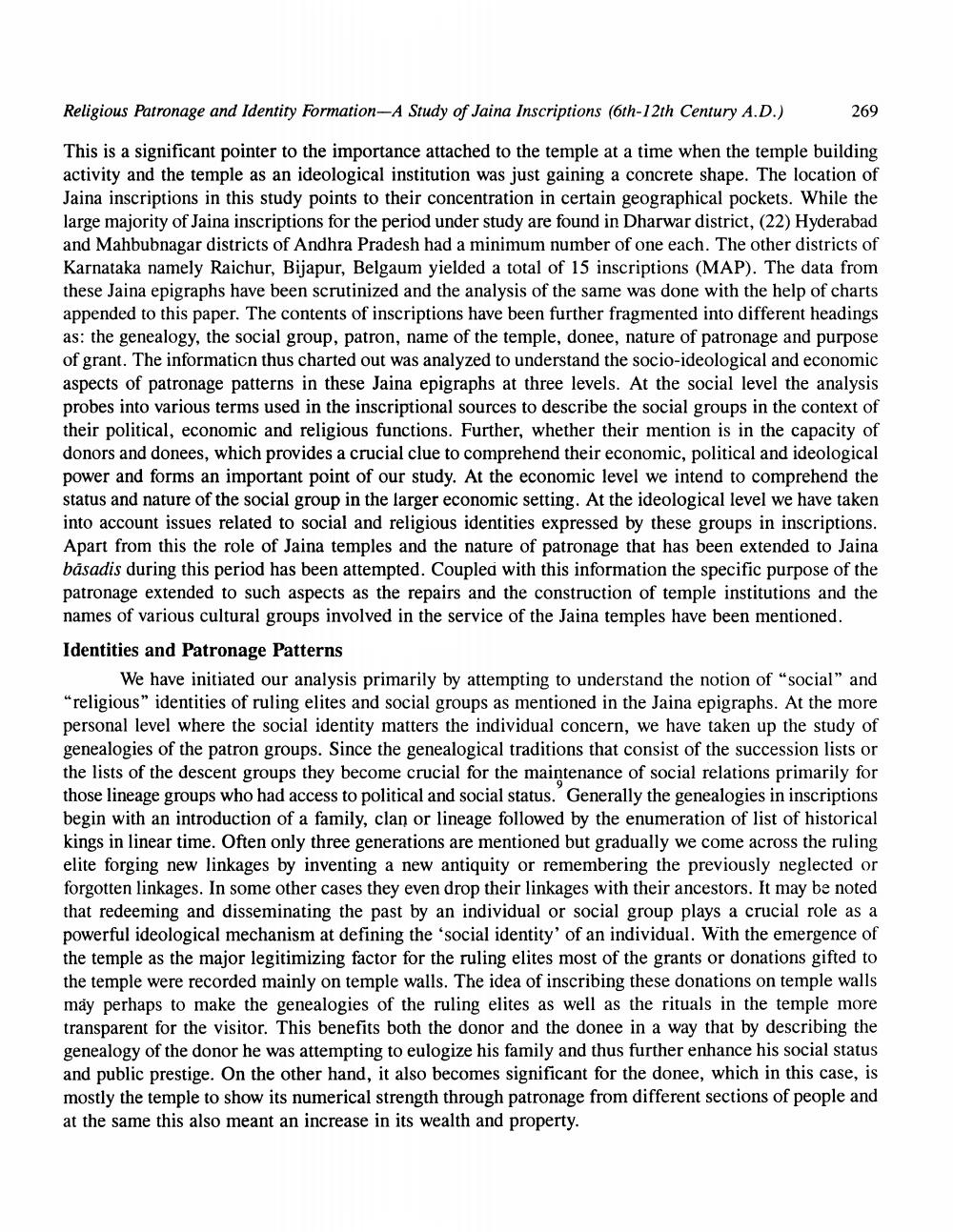________________
Religious Patronage and Identity Formation-A Study of Jaina Inscriptions (6th-12th Century A.D.)
269
This is a significant pointer to the importance attached to the temple at a time when the temple building activity and the temple as an ideological institution was just gaining a concrete shape. The location of Jaina inscriptions in this study points to their concentration in certain geographical pockets. While the large majority of Jaina inscriptions for the period under study are found in Dharwar district, (22) Hyderabad and Mahbubnagar districts of Andhra Pradesh had a minimum number of one each. The other districts of Karnataka namely Raichur, Bijapur, Belgaum yielded a total of 15 inscriptions (MAP). The data from these Jaina epigraphs have been scrutinized and the analysis of the same was done with the help of charts appended to this paper. The contents of inscriptions have been further fragmented into different headings as: the genealogy, the social group, patron, name of the temple, donee, nature of patronage and purpose of grant. The informaticn thus charted out was analyzed to understand the socio-ideological and economic aspects of patronage patterns in these Jaina epigraphs at three levels. At the social level the analysis probes into various terms used in the inscriptional sources to describe the social groups in the context of their political, economic and religious functions. Further, whether their mention is in the capacity of donors and donees, which provides a crucial clue to comprehend their economic, political and ideological power and forms an important point of our study. At the economic level we intend to comprehend the status and nature of the social group in the larger economic setting. At the ideological level we have taken into account issues related to social and religious identities expressed by these groups in inscriptions. Apart from this the role of Jaina temples and the nature of patronage that has been extended to Jaina basadis during this period has been attempted. Coupled with this information the specific purpose of the patronage extended to such aspects as the repairs and the construction of temple institutions and the names of various cultural groups involved in the service of the Jaina temples have been mentioned. Identities and Patronage Patterns
We have initiated our analysis primarily by attempting to understand the notion of "social" and "religious" identities of ruling elites and social groups as mentioned in the Jaina epigraphs. At the more personal level where the social identity matters the individual concern, we have taken up the study of genealogies of the patron groups. Since the genealogical traditions that consist of the succession lists or the lists of the descent groups they become crucial for the maintenance of social relations primarily for those lineage groups who had access to political and social status. Generally the genealogies in inscriptions begin with an introduction of a family, clan or lineage followed by the enumeration of list of historical kings in linear time. Often only three generations are mentioned but gradually we come across the ruling elite forging new linkages by inventing a new antiquity or remembering the previously neglected or forgotten linkages. In some other cases they even drop their linkages with their ancestors. It may be noted that redeeming and disseminating the past by an individual or social group plays a crucial role as a powerful ideological mechanism at defining the 'social identity' of an individual. With the emergence of the temple as the major legitimizing factor for the ruling elites most of the grants or donations gifted to the temple were recorded mainly on temple walls. The idea of inscribing these donations on temple walls may perhaps to make the genealogies of the ruling elites as well as the rituals in the temple more transparent for the visitor. This benefits both the donor and the donee in a way that by describing the genealogy of the donor he was attempting to eulogize his family and thus further enhance his social status and public prestige. On the other hand, it also becomes significant for the donee, which in this case, is mostly the temple to show its numerical strength through patronage from different sections of people and at the same this also meant an increase in its wealth and property.




